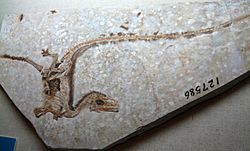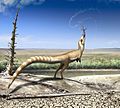Sinosauropteryx facts for kids
Quick facts for kids SinosauropteryxTemporal range: Lower Cretaceous
|
|
|---|---|
 |
|
| Scientific classification | |
| Kingdom: | |
| Phylum: | |
| Class: | |
| Superorder: | |
| Order: | |
| Suborder: | |
| (unranked): | |
| Family: |
†Compsognathidae
|
| Genus: |
†Sinosauropteryx
Ji & Ji, 1996
|
| Species | |
|
|
Sinosauropteryx was a small dinosaur that lived a very long time ago. It was not a bird, even though it had special features that looked like feathers.
This dinosaur is famous because it was the first one ever found with clear signs of furry, down-like feathers. These feathery parts looked a lot like the soft down on some modern birds that can't fly.
Sinosauropteryx lived in China during the early Cretaceous period. It was a close relative of another dinosaur called Compsognathus. Scientists believe it lived about 124.6 to 122 million years ago.
Its fossils were discovered in a special area in Liaoning Province, China, called the Jehol biota. This place used to be an ancient lake bed, which helped preserve the dinosaur's delicate features.
Most scientists do not consider Sinosauropteryx to be a bird. This is because it is not closely related to Archaeopteryx or modern birds.
Sinosauropteryx prima was one of the smallest non-bird theropod dinosaurs. The main fossil found, which was almost fully grown, was only about 68 centimeters (27 inches) long. This length included its very long tail.
What Color Was Sinosauropteryx?
A scientist named Nick Longrich suggested that the fossils of Sinosauropteryx still show its original colors. He noticed dark, striped patterns on the tail. These patterns were too regular to be just random marks on the fossil. He believed they were fossilized pigments, which are the natural colors found in feathers.
The dark feathers found only on the top of its body also suggest its real-life color pattern. This means Sinosauropteryx prima likely had a special kind of camouflage called countershading. It would have been dark on its back and lighter on its belly. The stripes on its tail would have helped it blend in with its surroundings. Later studies showed its main color was a ginger (reddish-brown) shade.
Images for kids
See also
 In Spanish: Sinosauropteryx prima para niños
In Spanish: Sinosauropteryx prima para niños









